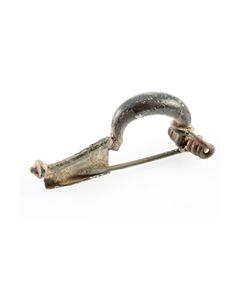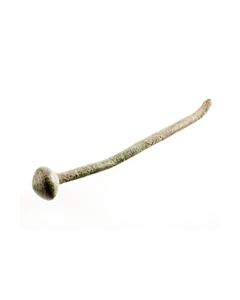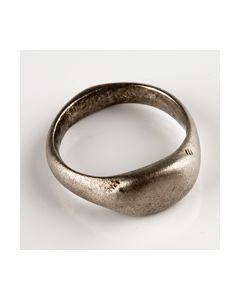Celtic - Jewellery - Southern Europe - Sold antiquities
Archive of sold antiquities
All artefacts sold in our gallery are fully documented in our online archive and database. Being a specialist ancient art dealer, preserving also the more recent history of each and every piece sold in our shop is at our heart. That is particularly useful for artefacts that changed owners in the meantime. Information that may have been lost in the process can be easily restored from our archives. Please do not hesitate to contact us if you need further information about ancient items that have been sold in our gallery. We can help you with reconstructing the history of ownership for those items. All information about our customers will be kept confidential, of course.-
 Celtic brooch from Iberia
Celtic brooch from IberiaThe early Celtic brooch dates from the 6th century BC and was found in Spain. This specimen is published in two standard works on ancient brooches.
Price: on request Celtic neck ring
Celtic neck ringOpen ring made of solid bronze. The torc is from Gaul or Central Europe and dates to the 4th or 3rd century BC.
Price: on request Gruppe römischer Ringe
Gruppe römischer RingeDiverse Ringe aus Bronze. 1. bis 4. Jh. n.Chr., römische Epoche. Germania Inferior.
Price: on request 2 Perlen mit aufgeschmolzenem Glas
2 Perlen mit aufgeschmolzenem GlasBlaue Glasperlen in Langform mit Spirale aus weißem aufgeschmolzenem Glas. Grabbeigabe der Kelten oder Römer.
Price: on request Römische Silberfibel
Römische SilberfibelMassive Fibel aus Silber. Fundort England, aus alter britischer Sammlung. Museumswürdiges Exemplar.
Price: on request Römische Nadel aus Bein
Römische Nadel aus BeinNadel oder Haarnadel aus Bein. Kunstvoll gearbeiteter Kopf. Fundort: White Noteley, Essex, England.
Price: on request Keltische Fibel aus Silber
Keltische Fibel aus SilberSeltener Typ mit Dekor, 1. Jh. v. Chr. - 1. Jh. n. Chr. Museales Stück mit schöner Tönung.
Price: on request Protogeld in Ringform, diverse Ausprägungen
Protogeld in Ringform, diverse Ausprägungen13 Ringgeldexemplare und ein Pelta-Amulett. Exzellent erhalten, mit schöner Fundpatina. In dieser Formenvielfalt selten angeboten.
Price: on request Keltische Fibel mit P-förmigem Profil
Keltische Fibel mit P-förmigem ProfilKeltische Fibel, Variante aus der La Tène-Zeit. Interessanter, massiver Typ aus dem 3. bis 1. Jh. v. Chr. 63mm lang, 25g.
Price: on request keltische - römische Gewandnadel oder Haarnadel aus Bronze
keltische - römische Gewandnadel oder Haarnadel aus BronzeSehr gut erhalten, leicht verbogen. Schöne Patina, kunstvoll gearbeitet.
Price: on request römisches Amulett in Form eines Beilkopfs
römisches Amulett in Form eines BeilkopfsAmulette dieser Art sind bereits aus dem 4. - 2. Jh. v. Chr. bei keltischen Stämmen belegt. In dieser Erhaltung selten.
Price: on request Früher Fibeltyp mit Zierplatte
Früher Fibeltyp mit ZierplatteAntike Fibel mit emaillierter Zierplatte. Schön patinierter Bronzekörper mit reichem Dekor. 2. Jh. v. Chr. bis 1. Jh. n. Chr.
Price: on request Frühe, europäische Fibel
Frühe, europäische FibelVollständig erhaltene, keltische Bronzefibel aus der Eisenzeit, 6. bis 3. Jh. v. Chr. Großartiges Beispiel für einen der frühesten Fibeltypen.
Price: on request Frühe, europäische Fibel
Frühe, europäische FibelHervorragend erhaltene, keltische Bronzefibel aus der Eisenzeit, 6. bis 3. Jh. v. Chr. Großartiges Beispiel für einen der frühesten Fibeltypen.
Price: on request Eisenzeitliche, europäische Fibel
Eisenzeitliche, europäische FibelHervorragend erhaltene, keltische Bronzefibel aus der Eisenzeit, 6. bis 3. Jh. v. Chr. Früher Fibeltyp in schöner Erhaltung.
Price: on request Keltische Fibel der Latènezeit
Keltische Fibel der LatènezeitAntike Gewandnadel aus Bronze. Variante der Jezerine-Typ-Fibeln, vermutlich aus Süddeutschland, 1. Jh. v. Chr.
Price: on request Römischer Ring aus Silber
Römischer Ring aus SilberRömische Kaiserzeit, möglicherweise aus der keltischen Provinz oder Provinznähe. Ringband geht nahtlos in die Ringplatte über. Theoretisch auch heute noch als Amulett oder Fingerring tragbar. Innendurchmesser 17mm bis 18mm.
Price: on request

